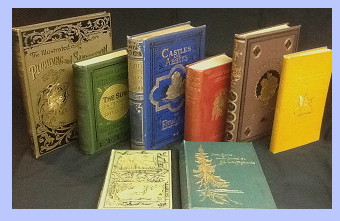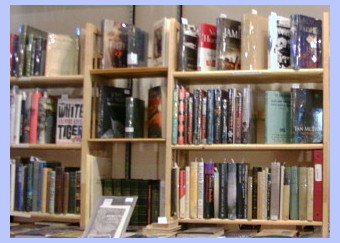Home | Conditions of sale, and orders
![]()
Home | Conditions of
sale, and orders
![]()
Return to main Special Features page | Return to Book Fairs 101 Intro page
This time I propose to tackle one of the hardest book fair related topics I know: How do you set up your booth to its best advantage? The answer to this question, of course, largely depends on the stock you select to bring with you - on this you're on your own! (If I knew which books would sell I'd only bring two boxes, and go home empty handed each and every time.) Their variety, age, size, and visual appeal; the breadth of subjects you carry; and the 'little extras' that go with them, all have an influence on how you arrange your books.
OK, so set-up has started and you're standing in your booth. The infrastructure is in place, and your first box of books stands open in front of you, one book in your hand. What do you do? How do you decide where to put it, or how to display it? Stand back, take a deep breath and think about the following things ...
Whether a specialist or general bookseller, we all have our intellectual subject categories, and group our books into them in our heads, our catalogues and our quotes, so why not do so in our booths as well? You'd be surprised at how many dealers don't, under the impression that if everything is mixed together, customers have to look at every shelf. This may work at a small fair where a customer has all day to wander through 35 or 40 booths, but at larger fairs - take, for example, the 200+ booth ABAA fair in San Francisco where the customers have an average of five minutes per booth from the moment the show opens to the moment it closes - s/he will by-pass the disorganized booth and put her/his time into one where there's a chance of finding something of interest. So, trust your instincts and group things logically.
Look at your stock, and ponder your potential customer. Different stock takes different treatment and you know yours better than anyone else. What do you find interesting about the books? What will attract the right kind of customer into the booth to look at them? How can you then show them to best take advantage of that?

We have it pretty easy. We're general dealers with a bend towards British Victorian books of all types; frankly, the odder, the more unconventional they are, the more we like them, especially if bound in gilt decorated cloth. Concentrating on items in near fine to fine condition makes it very easy to create a bright, visually interesting display that shows off our wide-ranging tastes. Choosing to prominently display eye-candy, pulls like-minded customers into the booth, where they then have a chance to see the less decorative titles on offer. | |

Harder are the displays of what one friend calls "brown leather". He specializes in early literature, mostly from the 17th and 18th centuries, and mostly bound in contemporary calf. Some customers know that that's what they want to see and aren't put off by shelf after shelf of leather, but what about those who are still setting their tastes, or who might find that odd, unusually-early piece in their field of interest?
| |

Modern books have their own challenges: most have visually appealing dust jackets; but, with the exception of special productions, they tend to be of limited sizes, and, when tightly packed on a shelf, they are almost as bland looking as any shelf of "brown leather" - maybe more so, as they're so new. Still, if all the covers are displayed, the massive impact can be overwhelming. The trick is to pick a small percentage - say 15% - of widely varied, but representative topics and/or recognizable authors/titles, and feature those. | |
So what have you got that will snag the attention of someone walking by? Where should they be placed to catch the eye of a passerby? You know your stock better than anyone, but remember that eye-level catches the passerby, but a well laid out display keeps their interest.
OK, so your books are unpacked and organized, and you've decided which ones would best attract attention; what should you think about while you fine tune your display? Foremost is to figure out what you can do to make it easy for people to see what you have, and know at a glance that they want to come in. To that end you'll want to keep a few things in mind.
Break up your display. Rather than having shelves packed full of books with spines facing out, leave enough room at the end of them to stand one or two attractive books facing front. Break up the eye, by turning some to the left, others to the right. Lean some back on stands to change their angle. The wider the variety of display tactics used, the more attractive the arrangement.
Show the titles. My philosophy is that no one should have to pick up a book to know what it is - if you know what it is you'll know if you want to look at it. Is the title only on the front cover, not on the spine? Lay it flat. Is it only on the spine? Leave it standing. Is there no external lettering at all? Open in to the title page on a cradle, or, prepare a printed label for insertion either on the front (for decorative covers) or along the spine (for plain ones).
Use all your space. Why leave useable display space empty? I sometimes walk into colleagues booths and am overcome with a desire to better show their books for them! They've left table tops clear, ends of shelves unused, corners unoccupied, and - sin of all sins - beautiful, fascinating books tucked away out of sight! (I also want to stand all books up nice and straight and put in book ends, but that's another story.)
Celebrate colour. One thing that books have going for them is colour, whether on decorative cloth, hand-coloured plates, elegant inlaid bindings, or dust jackets from the last 100 years. Use it. Scattered through your booth they can attract attention; spaced with less vibrant, but interesting neighbors, they can capture a buyer's attention and pull it into where s/he'll see the adjacent books as well. In booths with a lot of similarly sized or coloured books, one splash of red can really work wonders, whether a gilt decorated binding or just a bit of velvet under a precious tome.
And, most importantly ...
... show how much you like your books! If you don't like them, they're going to be much harder to sell. Treat 'em right, tart 'em up and, show 'em off. Customers always appreciate a dealer's enthusiasm.

Return to main Special Features page | Return to Book Fairs 101 Intro page
Home | Conditions of sale, and orders
Last updated: 04/02/2017
Site maintained by Susan Ravdin